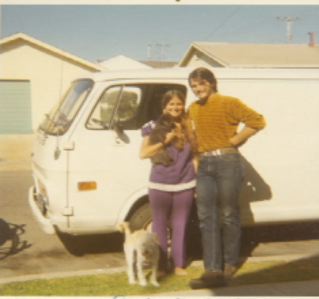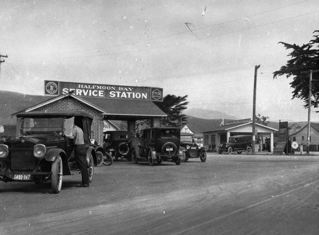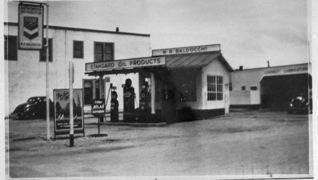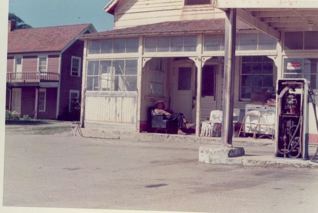My Search for the Beatniks Who Lived at the “Abalone Factory,” Princeton-by-the-Sea: Part IV

Marvin Lewis (ML): I called [my client] Carol and I said, ‘Carol, please, this young man–I don’t want to tell tales out of school’ — but, she said, ‘Why didn’t you accept this girl? He gives her to you graciously.
ML: Carol, this isn’t my world
ML (to June): Two weeks later McCracken came in with another little girl–same thing. Same–and this time I made it more forceful than ever. Several days later he said he had to see me so he came in to my office.
Michael McCracken (MM): I must have been nuts. I know why you didn’t want these women……You want me!!!!
ML: I don’t want you.
MM: I don’t understand what you do want.
ML: Just don’t worry about it.
ML (to June): Anyway, we went along preparing for the trial. Then they sprung the news on me that he [McCracken] had gotten her [Carol] pregnant. I figured I couldn’t very well bring her in front of the jury. She was starting to show and we got the trial ppostponed until the baby could be born. The baby was born down in Princeton where they moved from North Beach.
Carol said it was hard for them to come into the City. They had to hitch rides in. They’d walk for miles to get to my office. She said it was most difficult to get to where the grocery store was. They had no car and they’d walk along the coast until they got to these little stores in Princeton to buy their food.
They were living with others from their group who had gone with them. They had taken over this deserted building.
Finally the day of the trial arrived and I warned them: Don’t have any of the beatniks come into the courtroom. But no matter what I said, they kept coming in.
So the mother came up with two of the daughters-and at my direction got Carol into a beauty parlor where she was coiffured, made-up and they bought her some clothes. She looked like a different person. I hardly recognized her. [McCracken] was very unhappy about this.
…To Be Continued…
My Search for the Beatniks Who Lived at the “Abalone Factory,” Princeton-by-the-Sea: Part III
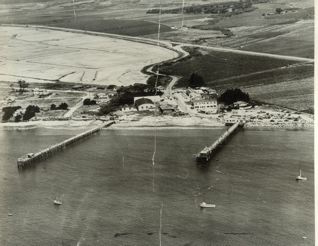
Marvin Lewis (ML) : So–in the interim a very peculiar thing that I wlll never forget as long as I live occurred. He came up to me one day and said, ‘You know, you’re a very interesting man.’ He said, ‘I find an empathy with you that I never have had with a capitalist world person and the establishment.’ He said, ‘You have made a good reputation for yourself and in your profession. You have money. You dress establishment, and yet,’ he said, ‘you see to fit in with my type of people, and I can have an understanding of you and I like you.’ He said, “I think you must have a rare faculty. You have the ability of living on both sides of the street’. But, he said, ‘I think to make your life fuller, you should have LSD and you should sniff glue’.
I said, Really. I have been doing very well without. In those days I’d never even heard of LSD–never heard of sniffing glue–and I said, I’m not really interested.
‘But’, he said, ‘I know you’re a great lawyer, but you’d be that much greater if you…And he said, ‘Another thing you should have some of our women in your life.’ He said, ‘I think you’re probably just making love to your wife and you need a lot more to broaden yourself’.
Marvin Lewis (ML): I don’t–I really thank you–and I really appreciate it all–but please, thanks, but no thanks.
ML (to June): I finally got them both out, and I went, Oh, my God, I don’t believe this just happened.
…To Be Continued…
My Search for the Beatniks Who Lived at the “Abalone Factory,” Princeton-by-the-Sea: Part II
Marvin Lewis (ML): One day I got a phone call. My secretary said this Carol was coming in with her boyfriend, McCracken. They came in.
I don’t remember whether I was in this building, or whether I was across the street at 703 Market.
Marvin Lewis: I remember that Carol had no make=up, that she wore these coarse black stockings as the beatnik girls then dressed. They all had a uniform just as the later flower children had their type of uniform.
Carol was adorable. Cute, darling girl. Pretty as a picture. Just lovely. When she was dressed up, it was unbelievable. It was like seeing another person. She had a great personality.
McCracken had an English accent. If ever there was a handsome man, he was it. He had big blue eyes, blond hair, spoke very elegantly–like a Doug Fairbanks, Jr. type of accent–but he was a rough type of man, wore a beard which wasn’t too common in those days.
McCracken was tall, six feet. Handsome tattered clothes. Big flowing hair. He was a most interesting man. I loved that English accent. What power he had over these women. Piercing blue eyes. Hypnotic.
After we discussed the facts of the case, he made it very clear to me that they didn’t want any capitalistic money paid to me, as he put it, for the payment of her case.
I said, well, the capitalist money is very good to me and I wouldn’t be taking the case if it wasn’t for that. I’ve already been paid, and very well paid by the mother.
He said, that’s not going to do. I’m going to paint you a beautiful painting, and I will give that to you in full payment for whatever service you perform.
I said, that’s entirely up to you. I’ll be very grateful for whatever you choose to do but it’s certainly not rquired.
…To Be Continued…
My Search for the Beatniks Who Lived at the “Abalone Factory,” Princeton-by-the-Sea: Part I

You might wonder–legitimately–why I was going to interview the stellar attorney Marvin Lewis for a story about beatniks at Princeton. My answer is, read and you’ll see why–or at least I think you will. Suffice it to say I that via my Coastside research there had been several references to beatniks living at the old Abalone Factory. I worked hard to find a link (and I’ll get back to that later).
And in the fall of 1979 I walked into Mr. Lewis’s office on Market in San Francisco. He had a full head of hair and his voice was strong and there was no doubt in my mind that he knew exactly what he was going to say–and nothing else.
Of course I was excited. To me, “the local historian,” this was a long way from stories about the Ocean Shore Railroad and artichokes–for me, this was going to be really good stuff. Unlike some of my local interviews with people who were reluctant to talk about the colorful prohibition era and their role in it, Marvin Lewis had no inhibitions whatsoever.
He was perfect the interview. He knew why I was there and he was ready to go and anxious to tell me the story he would never forget. (Marvin Lewis passed away in 1992).
June: [I got straight to the point]: How did you get involved with Michael McCracken?
Marvin Lewis: Well, I’ll tell you how I became involved. In my early years of the law, and I still do some criminal work, I did heavier criminal work. I don’t know how many years we’re going back. I can’t place it exactly. I know I was living in Hillsbourugh so it has to be within the last 20 years.
Maybe 15 years ago if we can place the beatnik era. But it seems that there was a superior court judge in Los Angeles County who knew of me as a lawyer in San Francisco. And he was a personal friend of a wealthy doctor and his wife. And they had three daughters. Two of the daughters had married establishment men and they lived in Beverly Hills and Westwood in L.A.
And, the daughter, Carol, had become, and we’ll use the term–a beatnik.
Mainly lived at that time drinking in the pubs, where the poets recited and the artists had their paintings.
[Carol] had been—was up for trial for the sale of cocaine. And I said I’d like to speak to the mother and the mother came up with one of the daughters, and a very elegantly dressed woman, and a very fine woman, and very distressed over the situation.
[Carol’s mother said her daughter] had been living with a man by the name of McCracken, an artist.
I named a fee. It was substantial and I was paid the fee. I said to have the daugher come in.
Fayden’s Peace Ballads For Sale–See Link Below
Look! Fayden’s Albums (now rare) Are Still Available
http://gemm.com/item/FAYDEN/PEACE–BALLADS/GML833931337/
PEACE BALLADS
FAYDEN
Jaw ART: An Interpretation
Coastside Gas Stations from the Past
1912: The Coastside’s Building Boom (Part V) Conclusion

(Photo: Marine View Tavern, Moss Beach)
In 1912 the new townsite of Montara was also gearing up for growth. Located some 22 miles south of San Francisco, Montara was situated “in a great amphitheater with a picturesque marine view.”
“…A great amphitheater with a picturesque marine view.” What a lovely description!
San Francisco publisher Harr Wagner, who headed the Montara Realty Co., was building for himself a ten-room villa with “large court, granite pillars and other amenities.”
Frank Brophy insisted that his “Princeton-by-the-Sea” was the grandest beach resort on the entire Pacific Coast. Under his auspices, the charming Hotel Princeton was constructed. A posted sign advertised that the new restaurant speciallized in fresh fish and Italian dinners available “at all times”–which was very convenient a few years later during the colorful, rowdy Prohibiton era.
Nearby “Princeton Park” became famous for its large dancing pavilion, measuring 60′ x 125′–and even more for its carnival atmosphere with challenging games and silly amusements.
But inevitably the flurry of building activity that energized the Coastside in 1912 subsided. Simultaneously, the pace of Ocean Shore Railroad service slowed down and eventually ceased. The reason: Real estate interest was now focussed on the busy San Francisco Peninsula.
In the meantime, the profitable Stine and Kendrick partnership broke-up, and Charles Kendrick went on to fufill his destiny in the upper echelons of business, commerce and politics. The other developers of the 1912 Coastside boom faded from the pictyure. Most of their buildings are gone as well.
1912: The Coastside’s Building Boom (Part IV)
Most astonishing were the statistics from June 1912: 30,000 passengers, commuters and picnickers had boarded the famous “Reaches the Beaches” Ocean Shore Railroad in San Francisco for the refreshing “voyage by rail” to Half Moon Bay.
The numbers showed a 100 per cent increase over the previous year!
And everybody raved about the Ocean Shore. Tourists declared the roller coaster train ride “the most magnificent combination of mountains and marine view that can be seen from a car window anywhere in the world.” The buzz was that it would become a “must see” side trip for every tourist visiting the Pacific Coast.
There were other plans to perk up the isolated, peaceful Coastside. One of the most ambitious was a “fine boulevard” that would link San Francisco with Half Moon Bay. At a crowded public meeting in Redwood City, a decision was made to hold a bond election to raise funds for the construction of “a great ocean boulevard from Golden Gate Park to all the shore towns of San Mateo County.”
Public school education shared the spotlight in the development explosion:Blueprints showed that Half Moon Bay High School and Farallon School in Montara were to be built in a style that tried to match the Spanish architecture see in the train stations built by the Ocean Shore.
Overlooking a lovely sheltered cove at Marine View in Moss Beach, a three-story, $25,000 Mission-style hotel was under construction. Summer cottages, a “pleasure pier”, bathhouses and concessions were to be built nearby.
The developer of the Marine View Hotel was very proud of the location near upscale Moss Beach, already touted as a place of “high character,” distinguished by its “artistic up-building” and what was called “protective restrictions” (I don’t know what “protective restrictions” means….)
…To Be Continued…


